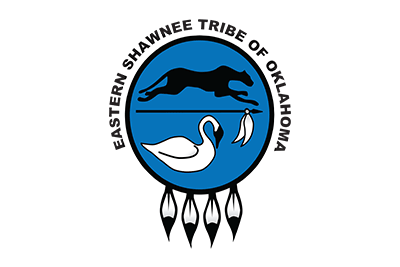Eastern Shawnee Tribe of Oklahoma Seal
 Five simple objects—a circle, one panther, a spear, one swan and a collection of four feathers—comprise the elements depicted in The Great Seal of the Eastern Shawnee Nation.
Five simple objects—a circle, one panther, a spear, one swan and a collection of four feathers—comprise the elements depicted in The Great Seal of the Eastern Shawnee Nation.
The emblems are simplistic in nature but complex in meaning. The circle with its vibrant blue coloring is continuous, never-ending, meaning no beginning, no ending but one world, one universe, one tribe of people. The round shape encircles and holds together all other objects, just as the tribe holds all members together as one.
The circle or universe is divided into two equal parts by a spear or lance with two feathers trailing downward near the tip of the spear. That spear with its two feathers symbolizes the resolve of tribal members to protect our dual universe and citizenship comprised of the United States of America and the Eastern Shawnee Tribe of Oklahoma. That spear means we will fight to our death to defend this very universe that we hold as sacred.
A large elongated black panther dominates the top half of the seal. This panther, seemingly stretched out in motion, represents strength, courage and prowess in battle.
Below the spear in contrast to the powerful black panther above rests a serene white swan. The symbolism of the two animals contrasts as much as the black and white colors contrast. The swan with the signature curvature of its long neck looks down in tranquility, representative of grace and dignity.
Four hanging eagle feathers at the bottom of the circle or universe complete the logo. Four is a number that frequently appears in Native American symbolism. The four feathers bring to mind the four elements of the earth, the four winds, the four directions or corners of the earth. And of course the feathers are eagle feathers. The eagle is the most highly revered species indicative of courage, spirit, strength and bravery. Additionally the eagle symbolizes power from a lofty position, meaning the eagle is the one closest to the Creator.






